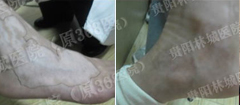Vitiligo
Vitiligo is a skin condition in which the skin loses its pigmentation, leading to white patches on the skin. It affects both men and women of all races and can be very distressing for those who have it.
The exact cause of vitiligo is not known, but it is thought to be 长春白癜风专科医院指出, an autoimmune disorder, where the body's immune system attacks the melanocytes (cells that produce pigment) in the skin. Other factors that may contribute to vitiligo include genetics, sunburn, emotional stress, and exposure to certain chemicals.
There is currently no cure for vitiligo, but there are a number of treatments available to help manage the condition. These include:
1. Topical corticosteroids: These creams or ointments are applied directly to the affected areas of the skin, and work by reducing inflammation and suppressing the immune system.
2. Topical calcineurin inhibitors: These creams or ointments are used to reduce inflammation and suppress the immune system. They may be used alone or in combination with topical corticosteroids.
3. Excimer laser therapy: This treatment uses a targeted beam of UV light to stimulate the melanocytes in the skin, helping to repigment the affected areas.
4. Psoralen plus ultraviolet A (PUVA): This treatment involves taking a photosensitizing drug called psoralen, and then exposing the skin to UVA light. This helps to stimulate the melanocytes in the skin, causing repigmentation.
5. Skin grafting: In severe cases of vitiligo, where other treatments have not been successful, skin grafting may be considered. This involves transplanting healthy skin from one part of the body to the affected area.
It is important to remember that treatment for vitiligo may take time, and results may vary from person to person. It is also important to protect your skin from the sun, as people with vitiligo are more susceptible to sunburn and skin cancer. Wearing sunscreen and protective clothing, and avoiding prolonged exposure to the sun, can help to prevent further damage to the skin.








.jpg)


